Canada AM: Inside new exhibit ‘Andy Warhol: Stars of the Silver Screen’
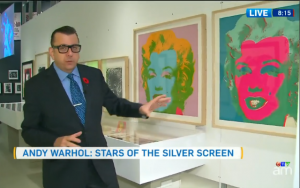 Richard takes “Canada AM” on a tour through the new Andy Warhol exhibit at the TIFF Bell Lightbox in Toronto.
Richard takes “Canada AM” on a tour through the new Andy Warhol exhibit at the TIFF Bell Lightbox in Toronto.
Watch the whole thing HERE!
 Richard takes “Canada AM” on a tour through the new Andy Warhol exhibit at the TIFF Bell Lightbox in Toronto.
Richard takes “Canada AM” on a tour through the new Andy Warhol exhibit at the TIFF Bell Lightbox in Toronto.
Watch the whole thing HERE!
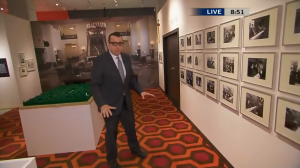 Richard takes a walk through the TIFF Bell Lightbox exhibit of the work of Stanley Kubrick. He highlights props from “Full Metal Jacket,” “The Shining,” “2001: A Space Odyssey,” “A Clockwork Orange” and “Barry Lyndon.” Click HERE to see “The Shining’s” axe and typewriter, Alex’s cane from “A Clockwork Orange” and much more!
Richard takes a walk through the TIFF Bell Lightbox exhibit of the work of Stanley Kubrick. He highlights props from “Full Metal Jacket,” “The Shining,” “2001: A Space Odyssey,” “A Clockwork Orange” and “Barry Lyndon.” Click HERE to see “The Shining’s” axe and typewriter, Alex’s cane from “A Clockwork Orange” and much more!
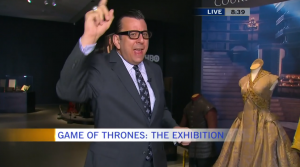 Richard walked through the Game of Thrones exhibit at the TIFF Bell Lightbox for Canada AM this morning. Join him as he has a look at the swords, skulls and augmented reality!
Richard walked through the Game of Thrones exhibit at the TIFF Bell Lightbox for Canada AM this morning. Join him as he has a look at the swords, skulls and augmented reality!
Watch the whole thing HERE!

 A strange action shot from the Q&A Richard hosted at the TIFF Bell Lightbox on Sunday February 9, 2014 with Oscar winning Brokeback Mountain composer Gustavo Santaolalla.
A strange action shot from the Q&A Richard hosted at the TIFF Bell Lightbox on Sunday February 9, 2014 with Oscar winning Brokeback Mountain composer Gustavo Santaolalla.
Here’s the info: I hosted a special afternoon with Oscar winning Brokeback Mountain composer Gustavo Santaolalla at the TIFF Bell Lightbox on February 9, 2014.
From TIFF.net: The Grammy-winning singer, guitarist and composer joins us during the world premiere of the dance musical Arrabal (running Feb 4 to April 20 at Toronto’s Panasonic Theatre) for a special screening of Ang Lee’s Academy Award-winning drama, for which he received an Oscar for Best Original Score.
 Richard will host a special afternoon with Oscar winning Brokeback Mountain composer Gustavo Santaolalla at the TIFF Bell Lightbox on February 9, 2014.
Richard will host a special afternoon with Oscar winning Brokeback Mountain composer Gustavo Santaolalla at the TIFF Bell Lightbox on February 9, 2014.
From TIFF.net: The Grammy-winning singer, guitarist and composer joins us during the world premiere of the dance musical Arrabal (running Feb 4 to April 20 at Toronto’s Panasonic Theatre) for a special screening of Ang Lee’s Academy Award-winning drama, for which he received an Oscar for Best Original Score.
More info HERE!
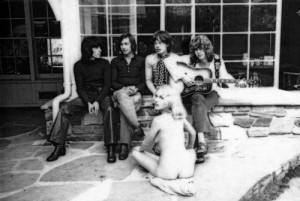 (From Richard’s book, “The 100 Best Movies You’ve Never Seen,” ECW Press 2003)
(From Richard’s book, “The 100 Best Movies You’ve Never Seen,” ECW Press 2003)
“It’s a fucking good film, Robert, but if it ever shows in America we’ll never be allowed in the country again.” – Mick Jagger to director Robert Frank
You probably haven’t seen one of the best movies about rock and roll ever made, and Mick Jagger wants to make sure you never do. “Cocksucker Blues,” the legendary documentary about the Rolling Stones, is so raunchy it even made the Fab Five blush. Although it was produced with the full cooperation of the band, they still took director Robert Frank to court to block distribution.
The Rolling Stones first met the Swiss-born photographer Robert Frank at a mansion in Los Angeles during the sessions for “Exile on Main Street.” As Europeans they shared a common fascination with American culture. The Stones were walking encyclopedias of Southern blues, while Frank had travelled the States in the mid-1950s snapping a series of photographs that would be released as a book titled ”The Americans.” By the time of their meeting in 1972 the Stones were the biggest rock band in the world and “The Americans” was already regarded as one of the classic photography books of the century.
After their initial meeting Frank was hired to provide cover art for “Exile on Main Street.” He gave them a photo h had taken in 1950 of a collage of circus freaks from the wall of a tattoo parlor on Route 66. The cover photo was met with such critical acclaim that the Stones decided to expand theoir working relationship with rank and hired him to shoot a no-holds-barred documentary of their 1972 American tour, to be produced by the legendary owner of Chess Records, Mashall Chess.
The Stones had not performed I the U.S. since the December 1969 debacle at the Altamont Racetrack, the final date of the tour that was filmed by Albert and David Maysles and released as a full-length feature titled “Gimme Shelter.” Shot in the waning moments of the 1960s, “Gimme Shelter” not only documents the actual end of the decade, but it ideological end as well. During the Altamont concert the Hel’s Angels, hired as security by the Stones, used pool cues and knives to beat an 18-year-old African-American audience member to death. AS the band played “Under My thumb” and Meredith Hunter lay dying on the ground, the image profoundly signaled the end of the era of peace and love. It was an historical moment and the Rolling Stones had it on film.
“Gimme Shelter” is an above-average rockumenary, and the inclusion of the controversial Altamont footage assured it would be successful. Three years later it was time for a follow-up. Jagger decided to call the movie “Cocksucker Blues” after a rough-and-ready tune he had written about a gay hooker in London, and gave Frank a full access pass to shoot wherever and whatever he wanted. That was a decision that would later come back to haunt the band.
Frank chose to shoot the film cinema verite style in black and white (with the odd bity of colour thrown in), which lends a stark newsreel feel to the movie. His dispassionate eye neither judges nor comments, preferring the viewer to draw their own conclusions as he films Keith Richard’s descent into heroin addiction or a battered woman trying to hide her face from the camera. There are many outrageous sequences in the film: saxophonist Bobby Keyes and Keith indulge in one of the great rites of passage for any rock star—throwing a television out of a hotel window; Keith advises Mick on the best way to snort cocaine; naked groupies masturbate for the camera—and one gets the feeling they are genuine, despite the Stones’ later claim that Frank stages some of the more decadent scenarios. As part of a legal settlement with the band rank was forced to add a disclaimer at the beginning of the movie stating, “all scenes except the musical performances are fictitious.”
To my mind the thing that makes this documentary special, setting it heads above the other anything-that-is-worth-doing-is-worth0-over-doing music movies is not the sensational sex, drugs and rock and roll footage, but the shots of the band in the downtime between concerts. This, I suspect is the side the myth-hungry Rolling Stones didn’t want you to see.
Frank unblinkingly shows us the tedium of life on the road, and allows the real lives of the band members to be revealed. Mick, the ultimate rock star, for example, is seen trying to deal with his high maintenance wife Bianca, who is often seen crying and playing with a small music box. The band is shown killing time between gigs be ordering room service, engaging in inconsequential conversations, or simply not speaking at all. This was hardly the high glam life that would be expected from the “World’s Greatest Rock and Roll Band,” although these are the scenes that humanize the group and put a pinprick in the bubble of fame that surrounded the Stones in their glory days. Director Jim Jarmusch called “Cocksucker Blues” “definitely one of the best movies about rock and roll I’ve ever seen. It makes you think that being a rock star is one of the last things you’d ever want to do.”
There are also some great in-concert moments, although “Cocksucker Blues” is by no means a concert flick. In one memorable sequence Frank intercuts backstage antics at roadies snorting coke with the Stones on-stage, creating a hypnotic tableau that shows both the public and private dichotomy of the group and life on the road. Other standout performances include an “Uptight”/”Satisfaction” medley (with Stevie Wonder), “Happy” and “Street Fighting Man.”
The era when it would be possible to make a film like this showing a band at this level is over. Now publicists would run interference at every stop, and every media-savvy groupie would demand a release form and a fee. “Cocksucker Blues” may represent our last truly unfettered look into the lives of rock gods at the peak of their fame. The practice of celebrity journalism has been dealt a mortal blow by overzealous celebrity minders whose purpose in life is to sanitize their client’s images and make sure that compromising situations like the ones in the movie never make the light of day.
Not everyone agrees with my assessment of “Cocksucker Blues” as the greatest (and most revealing) rock movie ever, least of all the Rolling Stones. “I thought it was a piece of shit actually,” Bill Wyman, the Stones original bass player told me in 2001. “I thought it was so amateur and poorly done. I just couldn’t relate to it. [Robert Frank] was obviously just looking for anything sensational. That’s why me and Charlie are hardly in it, because we weren’t sensational. All the good bits, I thought, were cut out. It was just like a poor home movie, shot badly. I couldn’t relate to it. I had no interest in it really.”
The film has had very few public screenings. Frank’s vision of the rock and roll superstardom may have been too raw for the Stones, who sued to have the film shelved. Instead of suppressing the film completely, they reached a complicated settlement that allows Frank to show the film once a year, as long as he is in attendance. Bootleg copies—with a picture quality that “sucks as much as the groupies” as one critic joked—have bee widely distributed and are available for rent in many places.
UPDATE: “Cocksucker Blues” screens on Friday, January 17 at 6:30 p.m. at the TIFF Bell Lightbox in Toronto, and “Pull My Daisy” screens on Saturday, January 18 at 4:30 p.m as part of Hold Still – Keep Going: Films by Robert Frank — The Free Screen’s annual artists’ retrospective for 2014, running from January 17 to January 20. Programmer Chris Kennedy presents four programmes on the work of photographer and experimental filmmaker Robert Frank. Although best known for his photographic series The Americans, Frank is also considered one of the most important independent filmmakers in post-war America.
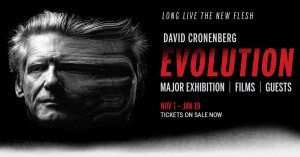 Have you ever wondered what a Mugwump looks like up close? How about the telepod that transformed Jeff Goldblum from man to insect? If you are a fan of Naked Lunch, The Fly or of David Cronenberg in general, you’ll want to make like the Reel Guys and head to the TIFF Bell Lightbox in Toronto to check out an elaborate and comprehensive exhibit detailing the director’s storied career. The show runs until Jan. 19, 2014, and presents an unprecedented look in to the mind and career of one of our greatest filmmakers. To prime the pump, the Reel Guys suggest some must-see Cronenberg films if you can’t make it to the exhibit.
Have you ever wondered what a Mugwump looks like up close? How about the telepod that transformed Jeff Goldblum from man to insect? If you are a fan of Naked Lunch, The Fly or of David Cronenberg in general, you’ll want to make like the Reel Guys and head to the TIFF Bell Lightbox in Toronto to check out an elaborate and comprehensive exhibit detailing the director’s storied career. The show runs until Jan. 19, 2014, and presents an unprecedented look in to the mind and career of one of our greatest filmmakers. To prime the pump, the Reel Guys suggest some must-see Cronenberg films if you can’t make it to the exhibit.
Richard: I am an unabashed fan of David Cronenberg. I felt like a kid in a candy store — or should that be an entomologist at a larvae convention? — at the exhibition and I regularly revisit his movies on DVD. One that always gets overlooked is Spider, a trip into the mind of a severely mentally disturbed man starring Ralph Fiennes. Fiennes is great in a virtually dialogue free performance but it is Miranda Richardson as several characters — all the women in Spider’s life — who really steals the show. It’s a spooky and cerebral thriller.
Mark: Spider was never one of my favourites although it does have a great twist ending. My thoughts on the Cronenberg oeuvre — and they’re almost all great — is how ahead of his time he’s been on our relationship to technology. When Videodrome came out, it was dismissed by a lot of critics. Now we live its reality every day. Same with Existenz. Both visionary films that prove how far ahead of the curve the director can be. But I think the quintessential Cronenberg film is Dead Ringers — a creepy Hitchcockian thriller that has Third Reich overtones of medical experiments and twins — and also because Cronenberg himself looks like a gynecologist harboring a terrible secret.
RC: I also have a soft spot for The Brood. It’s probably Cronenberg’s most traditional horror film, and I take delight in loving a movie Leonard Maltin rated a “Bomb.” Featuring Oliver Reed as an experimental psychotherapist, Samantha Eggar as a fetus-licking mother and murderous psychoplasmic offspring, it is the very stuff that nightmares are made of. It’s lesser seen than The Fly or Dead Zone and way more down-and-dirty, but for sheer scares it’s hard to beat.
MB: I like the brood but I prefer the Dead Zone even though legend has it that Cronenberg regretted doing a movie with all the incumbent studio interference. Know what? It still works. But Cronenberg will forever be one of my favourite directors if for no other reason than breathing life into Naked Lunch. A book I should have loved but could never get through — until I saw the film.
RC: He’s audacious. He made an unfilmable book filmable and opened a lot of people’s minds to reading author William S. Burroughs.
MB: He did the same thing with Cosmopolis, although I must say I didn’t need to see Rabid to appreciate Marilyn Chambers.